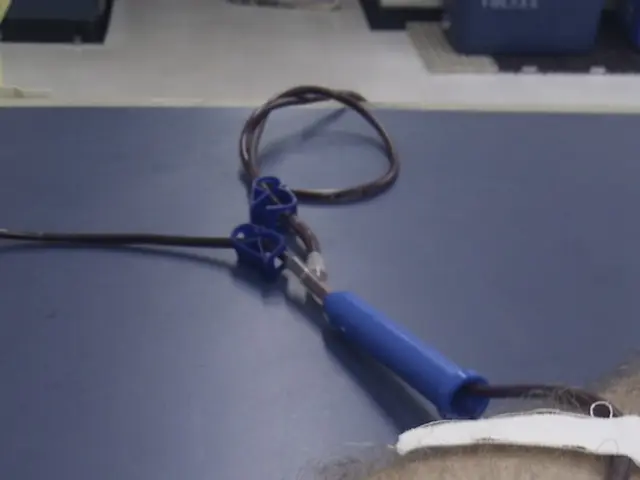Stomach ulcer endoscopy: Details on the process and additional information
Stomach ulcers, a common gastrointestinal issue, are often diagnosed through an upper gastrointestinal endoscopy, a minimally invasive procedure that offers a direct view of the stomach lining [1][2][3][5]. This article aims to provide an overview of the causes, diagnosis, treatment, and prevention of stomach ulcers.
Causes and Symptoms
The most prevalent causes of stomach ulcers diagnosed by endoscopy are infections with the bacterium Helicobacter pylori (H. pylori) and long-term use of non-steroidal anti-inflammatory drugs (NSAIDs) such as ibuprofen [1][2][3][5]. Other contributing factors that exacerbate symptoms include smoking, alcohol consumption, stress, and, in some cases, dietary factors like spicy foods [1][3][4].
Symptoms of a stomach ulcer can include abdominal bloating, pain or discomfort in the upper part of the abdomen, belching, feeling full quickly when eating, nausea, feeling uncomfortably full after eating, vomiting, and other related symptoms [1].
Diagnosis
Diagnosis is typically confirmed through upper gastrointestinal endoscopy, which allows direct visualization of ulcers, and can include biopsy and tests for H. pylori such as breath, stool antigen, or blood tests [2][3].
Treatment
Treatment primarily depends on the ulcer’s cause: For H. pylori infection, a combination of antibiotics (such as amoxicillin, clarithromycin, metronidazole, tetracycline) along with acid-suppressing drugs (proton pump inhibitors like omeprazole or lansoprazole, or H2 blockers like ranitidine) is used to eradicate the bacteria and promote healing [1][2][3][5].
For NSAID-induced ulcers, discontinuation or replacement of NSAIDs, acid suppression therapy, and protective agents like sucralfate are recommended [1][2][4]. Lifestyle modifications are also essential adjuncts, including quitting smoking, reducing alcohol intake, managing stress, avoiding spicy and fatty foods, and eating smaller, frequent meals [1][3][4].
Post-Procedure Care
An endoscopy is performed in an outpatient or hospital setting, and the patient is administered a mild sedative intravenously [2]. After the procedure, the individual is moved to a recovery room to rest for about 1-2 hours as the sedative wears off, and they will typically rest at home for the remainder of the day [4].
Prevention and Follow-up
People presenting with stomach ulcer symptoms should consider scheduling an appointment with a doctor [6]. In some cases, doctors may recommend a repeat endoscopy after completing treatment to ensure the ulcer has healed or has not become cancerous [3].
Individuals should discuss what they need to do before the procedure with the doctor who ordered the endoscopy, discuss any medications and supplements they are taking, and likely need to stop eating and drinking for about 8 hours before the procedure [7].
When they are able to swallow as usual after the endoscopy, people can return to eating their typical diet [8].
Emergency Situations
If a person experiences sudden, sharp, and severe abdominal pain that does not disappear, rapid pulse or other signs of shock, black or tarry stool, blood in the stool, vomit resembling coffee grounds or blood in the vomit, fainting, dizziness, changing or worsening ulcer symptoms, they should contact emergency medical services by calling 911 right away [3].
Conclusion
Stomach ulcers, while common, can cause significant discomfort. By understanding their causes, symptoms, diagnosis, treatment, and prevention, individuals can take proactive steps towards maintaining their gastrointestinal health. If you suspect you have a stomach ulcer, consult with a healthcare professional for appropriate evaluation and treatment.
- Science and medical research have provided insights into the causes of stomach ulcers, with infections by the bacterium Helicobacter pylori (H. pylori) and long-term use of non-steroidal anti-inflammatory drugs (NSAIDs) being some of the most prevalent factors.
- Chronic diseases like stomach ulcers can be managed effectively, with diagnosis typically confirmed through an upper gastrointestinal endoscopy, which allows direct visualization of ulcers, and tests for H. pylori.
- In the treatment of stomach ulcers, healthcare professionals often use a combination of antibiotics and acid-suppressing drugs for H. pylori infection, while discontinuation or replacement of NSAIDs, acid suppression therapy, and protective agents may be recommended for NSAID-induced ulcers.
- Health and wellness are significantly impacted by conditions like stomach ulcers, underscoring the importance of lifestyle modifications such as quitting smoking, reducing alcohol intake, managing stress, avoiding spicy and fatty foods, and eating smaller, frequent meals to prevent and manage stomach ulcers.




